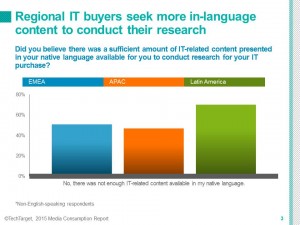
As you plan your content marketing efforts for 2015, there are a number of things to consider when it comes to development and distribution of your content within specific global regions. One of the most important thing to understand is whether you are effectively localizing your content for the markets you do business in.
IT buying is progressing in every major region
Online research is progressing just as fast in EMEA, APAC, and LATAM as it is in North America. According to TechTarget’s Media Consumption research, 68% of all technology buying decisions are made in 6 months or less across the globe. In fast emerging regions of APAC and LATAM, decisions are being made significantly faster than they were 3 years ago. With faster decisions being made, IT buyers are doing more research in a shorter period of time, which means that they need more content than ever before to support those decisions.
But content strategies are not keeping pace

While buyers universally will gravitate towards content that delivers valuable information (regardless of language), it is clear that a large number of buyers are wholly unsatisfied with the amount of content available in their native language, including half of buyers in EMEA and APAC and over 70% of buyers in Latin America. That means that every time a global marketer chooses not translate or localize content in non-English regions, they are missing a considerable amount of buyers in those markets.
Up until this point, English has been a default for a large number of buyers, but only due to necessity and availability in markets. Oftentimes, the amount of deep, technical information IT buyers need to solve problems is simply not offered in local language. This means the market opportunity for vendors who can produce this content is huge.
But how do companies get started and prioritize these efforts? Following is a checklist to help you develop and stick to a localization plan.
Content localization checklist – 6 things technology marketers must consider to succeed in 2015
1. Prioritize your markets
Which countries/regions are you most focused on? Budgets are rarely infinite. It may seem simple, but you must prioritize translation/localization in your most important markets. Assess the needs of the business to understand how much and how deeply you need to translate and localize assets.
2. Weight your content portfolio appropriately
Unfortunately, there is no golden number when it comes to what percentage of your portfolio you need to localize to specific progress in regions and/or countries. Ideally it would be 100%, but we all know that is not realistic. The truth is, any amount of resource and time you put against this effort will help you move the needle. When given a choice, all buyers would choose to download content in local language. But depending on where you market, there are varying degrees as to which markets truly require it.
To better guide how you weigh the amount of assets that should be translated/localized, here is a list of how some key non-English technology markets shake out:
Likelihood to download native language content rather than English language content*
Europe
DACH 23%
Spain 27%
France 30%
Asia
China 70%
Japan 76%
Latin America
Mexico 14%
Brazil 20%
While the limited availability of local assets in market greatly skews these results, it gives marketers a closer look at where generally to give higher weight to localized assets.
Outside of China and Japan, I would recommend a baseline of 50/50 split of localized to English assets. You can dial that up and down based on the above thresholds and your own market priorities, but this approach will help you both penetrate markets and deliver higher engagement with key local buyers that matter most to you.
* 2015 TechTarget media Consumption research – non-English respondents
3. Lead with your best performing content
IT problems are universal. Buyers around the world fundamentally have the same problems and go about solving them in the same way. Chances are, the best performing assets in North America when localized, would also perform very well in local markets. Assets that you get no traction with domestically are not worth the time and resources to translate or localize.
4. Localization doesn’t just mean translation
Often, marketers confuse translation and localization. Localization applies to both translated content and English-language content. There is a misconception that just because you aren’t translating doesn’t mean you don’t need to localize. And conversely, just because you translate doesn’t mean you don’t need to localize as well. Even if you are running North American content in the United Kingdom, you should make an effort to localize this content as much as possible.
5. Consult your local teams
Research and statistics are one thing, but in your local teams, you have a wealth of information on what will work and what won’t and the resources to help advise content development with response and cultural engagement in mind.
6. Test and measure
This is a fluid process that needs to be adjusted as you see gains in each market. With the help of your aforementioned local teams, you must continually monitor the weighting of your assets and the response and demand they are generating for you in market.
If you would like to learn more about how to go about setting localization priorities, please feel free to leave a comment or connect with me on Twitter or LinkedIn.




